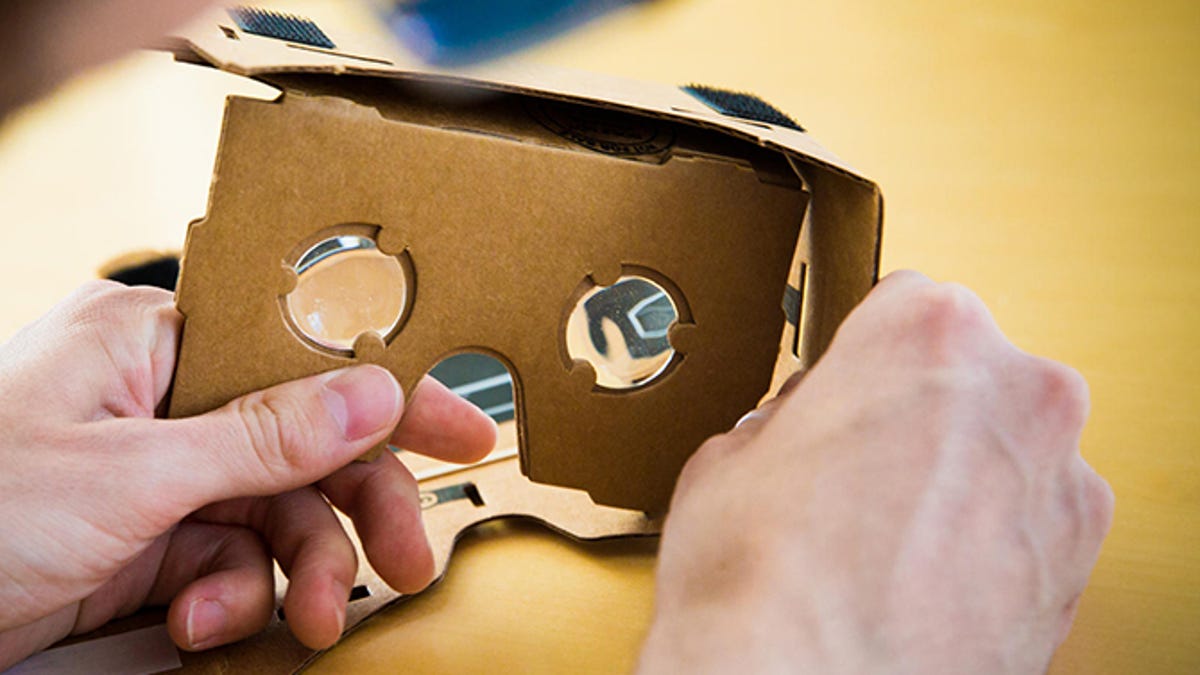
CNET
It’s time for Cardboard 2.0 and Google’s latest push with virtual reality.
Google on Thursday detailed its newest virtual reality device, the second-generation Cardboard. The new version is an even simpler product than the initial device, taking only three steps to construct instead of 12, and it also fits larger phone sizes, including screens up to 6 inches.
Unlike virtual reality rivals that have created systems that cost hundreds of dollars, Google has been pushing an inexpensive product that essentially anyone could afford and build, opening up VR to a broader group of consumers.
The second-generation Cardboard also includes a change in a button to cardboard from the first generation’s magnet to make input functions work with all devices. It went on sale Thursday with partners, and Google will hand out the device to everyone at its I/O developer conference — where the product was unveiled — said Clay Bavor, vice president of product management.
Along with Cardboard, Google also unveiled “Expeditions,” a new VR tool for schools. It will allow teachers to take students on virtual tours of different locations. The company also introduced its “Jump” system to capture VR video. It’s partnering with GoPro on Jump, which is comprised of three parts — a camera rig, an assembler that turns raw footage into VR video, and a player. The rigs include 16 camera modules mounted in a circular array, and users will be able to view the virtual reality videos on YouTube starting this summer.
“Jump is about capturing the world’s places in VR video,” Bavor said. “Expeditions lets teachers take field trips to anywhere…And Cardboard is about VR for virtually everyone.”
Google has been increasingly ambitious about expanding its scope of products beyond its juggernaut search engine. Its search and advertising business is still the most dominant in the world, making more than $50 billion a year. But as the Internet evolves, CEO Larry Page has been looking to where future revenue streams will come from. The company has made big bets in everything from smartphones to wearable devices to driverless cars.
See also
- CNET’s full Google I/O coverage
- Virtual reality wants to rule video games. Here’s who will rule VR
- Google Cardboard, Version 2: How VR and AR could take off at Google I/O
- Google’s cardboard VR headset is no joke — it’s great for the Oculus Rift
- Getting started with Google Cardboard
To get developers excited about its software, Google hosts the annual developer conference, called Google I/O. The keynote typically features new products and innovations, such as these in VR. This year’s event kicked off Thursday at the Moscone Center in San Francisco.
Google unveiled its first virtual reality efforts at last year’s I/O conference with the tongue-in-cheek Cardboard device. The company — which has become known for giving out expensive gadgets like Chromebook laptops or smartwatches to conference attendees — also gave developers at the event a Cardboard kit, including about $20 worth of trinkets like brass fasteners and rubber bands to keep the project inexpensive.
But the kit was more than a joke, as Cardboard 2.0 shows. The company has begun to invest in earnest in virtual reality — it has put out job postings to grow the team. Google has also begun to bring its nascent efforts to market little by little. In February, the company partnered with toymaker Mattel to create a new version of the Viewmaster, the iconic toy that lets you see different scenes by looking through a mini projector. Google’s version, which comes out in the fall and will cost $30, requires a smartphone to make it work.
The company is trying to keep pace with other tech giants, from Facebook to Microsoft to Samsung, which have also introduced major virtual reality initiatives. Facebook bought the VR headset maker Oculus a year ago for more than $2 billion. Facebook will launch a consumer version of the product next year. Samsung partnered with Oculus to create Gear VR, which is compatible with its flagship smartphones released over the past year, including the Galaxy S6 and S6 Edge smartphones. Microsoft in January unveiled its own take on the technology, called Hololens.
Google on Thursday said there are hundreds of apps available for Cardboard, and more than 1 million people using the device.
“People keep finding new and creative uses of cardboard in VR,” Bavor said. “One guy even proposed to his girlfriend with the help of Cardboard.” She said yes.
Here’s a roundup of all of today’s Google I/O news.
Building Google’s low-cost cardboard version of an Oculus Rift (pictures)









